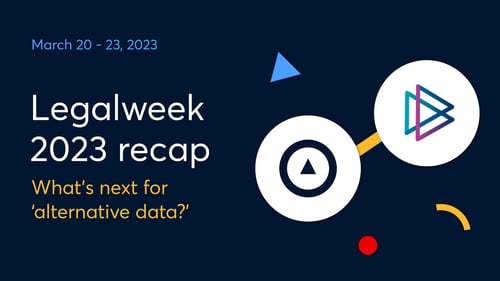Legalweek NY 2023 recap: What’s next for ‘alternative data?’

The sudden shift to remote work in 2020 forced organizations to accelerate their adoption of cloud-based applications to support this new way of working. Now, nearly three years later, legal teams face a significant challenge as litigation related to content created on these platforms increases.
To address this issue, we assembled an expert panel for this year’s Legalweek New York, featuring industry leaders on the front lines. The panel included Sharika de Freitas, VP of Information Governance and Legal Operations at Paramount, James Sherer, Partner at BakerHostetler, and Kelly Twigger, Principal at ESI Attorneys.
Pedro de Lencastre, Customer Success Director at Onna, moderated the panel discussion, which delved into the rapid evolution of data in recent years and provided the following insights into this new landscape.
The emergence of a new norm
The 2023 Businesses at Work report by Okta reveals that large companies with 2,000 or more employees now use an average of 211 applications, a 24-app increase from the previous year. Even smaller businesses reported using over 90 apps.
While not every app contains relevant data for eDiscovery, this trend underscores a growing concern for in-house teams, law firms, and service providers: effectively managing the rapidly increasing volume of collaboration, communication, and content data. To overcome this challenge, legal professionals must adapt and become proficient in best practices for managing the systems powering their businesses and responsibly governing data.
What is alternative data?
Alternative data originates from non-traditional information sources, such as collaboration, content, and chat applications, and can be either structured or unstructured.
Structured data is organized and easily searchable, whereas unstructured data lacks predefined formatting and poses greater analytical challenges. Unstructured data covers a broad spectrum of content types, including threaded messages in Slack or Teams, Zoom meeting recordings, ephemeral messages in Telegram, and wikis in Confluence or Notion. This data may also include elements like emojis, GIFs, unique reactions specific to certain operating systems, attachments, and hyperlinks.
Types of alternative data
Various alternative data types exist (including those previously mentioned), and many have already served as evidence in legal proceedings, such as:
- Content-centric alternative data. This data comes from applications that focus on content creation, editing, organization, and sharing. It includes data from document editing tools like Google Docs, file storage and sharing services such as Box and Dropbox, and wikis like Confluence and Notion. In the Twitter, Inc. v. Musk case, the defense asked Chancellor McCormick to require the plaintiff to collect and analyze 520,000 Confluence pages. These pages might have contained relevant technical documents, including the plaintiff’s spam auditing methodology – a crucial aspect of the case. However, the rulings didn’t specify a resolution for this request.
- Collaboration-related alternative data. This data is generated by online collaboration platforms like Slack or Microsoft Teams, shared documents such as Google Docs, Sheets, or Slides, and project management or issue-tracking tools like Jira or Zendesk. These apps help users coordinate efforts, share resources, track progress, and provide real-time feedback. They often include task management, file sharing, screen sharing, and version control features, enabling efficient and seamless collaboration. In the patent infringement case Benebone LLC v. Pet Qwerks, the court held that Slack messages were discoverable as evidence.
- Communication-oriented alternative data. This data originates from publicly accessible communication platforms like Twitter, Facebook, and Instagram, email services such as Gmail and Microsoft Outlook, and other communication tools like Teams and Zoom. Communication apps offer various channels for information exchange, including images, emojis, GIFs, audio, video, and more. In 2021, 166 U.S. court cases referenced emojis and emoticons.
Most companies use a combination of all three of these categories, so it's essential to be familiar with your organization's tech stack and the unique types of data present in each source.
Shaping the future: Recent case law impacting alternative data
During the lively discussion, our expert panel actively explored pertinent case law affecting alternative data and an organization's obligation to manage it effectively. The following cases were discussed:
- Red Wolf Energy Trading, LLC v. BIA Capital Mgmt. In an order so lengthy it needed a table of contents, a Massachusetts District Judgegranted a default judgment against BIA Capital Management due to discovery misconduct. This misconduct included failing to produce 47 documents from the defendant's Google Vault system, several relevant Excel and PowerPoint files, and a crucial "smoking gun" Slack exchange.
Key takeaway: To fulfill your preservation and production obligations, identify suitable collection tools for each source of electronically stored information (ESI), and engage experts if you’re unfamiliar with the necessary tools. - Nichols v. Noom Inc. In this New York case, Magistrate Judge Katherine H. Parker denied the plaintiff’s motion to reconsider the production of hyperlinked documents. The judge based her decision largely on the parties' failure to specify how to handle such documents in their ESI protocol. Although this implies that hyperlinked documents are not currently classified as attachments, a future case could rule differently if an ESI protocol addressed the handling of hyperlinked documents.
Key takeaway: Before accepting technology solutions, parties must fully understand the scope of an issue and ensure it’s effectively addressed. It’s also crucial to comprehend the terms of an ESI protocol agreement before agreeing to them. - Rossbach v. Montefiore Medical Center. In a case involving alleged sexual harassment, variations in emoji versions helped identify fabricated evidence of retaliation. The court determined that an evidentiary screenshot featuring the heart eyes emoji was created by someone on iOS13 or later. Since the plaintiff’s iPhone 5 couldn’t run anything higher than iOS10, the evidence was deemed fabricated.
Key takeaway: In litigation involving emoji depictions, it’s essential to have both the sender's and recipient's views. If you cannot replicate the evidence in its original format, obtain declarations from your litigation opponent regarding the alleged hardware and operating system versions. Additionally, make sure you understand how your solution works with emojis.
Preparing for the future: Tips for navigating the challenges of alternative data
Organizations must proactively address the unique challenges posed by alternative data sources and types. As data volumes soar and become increasingly complex, it’s crucial for businesses to skillfully navigate the legal, regulatory, and technical landscapes associated with their data. Here are some useful strategies for managing the risks and responsibilities related to handling alternative data:
- Understand the data your organization uses, its applications, and establish an evaluation process for this data.
- Conduct a litigation risk assessment for the data, focusing on prioritizing communication data.
- Identify a suitable eDiscovery solution tailored to the specific data types involved.
- Align information governance with eDiscovery requirements, taking into account privacy regulations like GDPR and CCPA, which may affect retention policies.
- Recognize that eDiscovery might be an exception to data privacy laws, and implement appropriate measures to ensure compliance.
- Evaluate the impact of legal holds on data retention and management.
- Remember that data collection is only part of the challenge; having efficient search and export processes in place is equally important.
Preparing for the future of alternative data management requires a holistic approach that addresses both the technical and legal aspects of handling such data. By grasping your organization's data usage, performing risk evaluations, pinpointing suitable discovery solutions, and reconciling information governance with eDiscovery and data privacy demands, you can effectively minimize potential risks and improve your data management processes.
About Onna
Onna solves the pressing data challenges faced by today’s enterprise businesses. These organizations often grapple with managing unstructured data from various collaboration, communication, and content applications, resulting in reduced efficiency and lost valuable insights. Onna enables leading organizations to consolidate their disparate data sources, such as Slack, Google Workspace, Microsoft 365, Confluence, Jira, and more, allowing them to search across a unified dataset and take prompt action when needed.
Our data management platform simplifies the process for corporate legal and IT teams, helping them discover and manage their data for eDiscovery, internal investigations, and information governance within a single, user-friendly platform. By leveraging Onna, businesses save time and resources, maximizing the value of their data at earlier stages of the process.
If you're interested in learning more, get in touch!
 eDiscovery
eDiscovery Collections
Collections Processing
Processing Early Case Assessment
Early Case Assessment Information Governance
Information Governance Data Migration
Data Migration Data Archiving
Data Archiving Platform Services
Platform Services Connectors
Connectors Platform API
Platform API Pricing Plans
Pricing Plans Professional Services
Professional Services Technical Support
Technical Support Partnerships
Partnerships About us
About us Careers
Careers Newsroom
Newsroom Reveal
Reveal Logikcull by Reveal
Logikcull by Reveal Events
Events Webinars
Webinars OnnAcademy
OnnAcademy Blog
Blog Content Library
Content Library Trust Center
Trust Center Developer Hub
Developer Hub